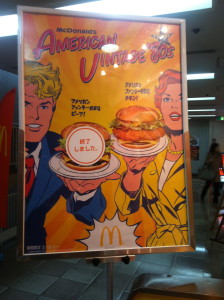This will be a short note. I apologize to my millions of loyal fans, for whom I’m currently working on a new full-size entry about a recent evening in Osaka. But I thought, living in a country virtually demolished by the victorious forces in World War II, I could leave a note on the 70th anniversary of that war’s most pivotal moment.
The year after D-Day was a historical period of extreme cultural exchange, perhaps not seen since First Encounter 450 years earlier. Within weeks, the French farmers and villagers of Northern France, celebrating their liberation, were tasting Coca Cola, trying bubble gum, playing baseball and listening to American music for the first time.
Fast forward to today. I work in Kyoto, Japan, the ancient capital of Japan and perhaps its most culturally valued, historically preserved city.
 Walking through Kyoto, one sees a Burger King dominating the city center, a Starbucks filled with youth, two or three McDonalds’ every square mile, Disney movies filling the theaters, “New York” Pizza stands, Facebook users, Instagrammers, even Japanese apps are named in English, the word “vintage” everywhere, English signs everywhere (and I really, really mean everywhere), etc. etc. Irrelevant but ironic is the widespread Japanese glorification of white people with blonde hair.
Walking through Kyoto, one sees a Burger King dominating the city center, a Starbucks filled with youth, two or three McDonalds’ every square mile, Disney movies filling the theaters, “New York” Pizza stands, Facebook users, Instagrammers, even Japanese apps are named in English, the word “vintage” everywhere, English signs everywhere (and I really, really mean everywhere), etc. etc. Irrelevant but ironic is the widespread Japanese glorification of white people with blonde hair.
We’ve brought America to every nation on Earth, and it began on the beaches of Normandy 70 years ago. I’m not sure how to feel about how far it’s come, but cheers to those who got the ball rolling, at high cost, and for the best reasons. USA number one.
-Greg

